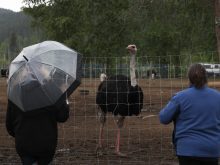Idaho has become the newest U.S. states to identify highly pathogenic avian influenza (HPAI) in a dairy cattle operation, the Idaho State Department of Agriculture (IDSA) confirmed March 30.
The affected dairy operation recently imported cattle from a state that has identified cases of HPAI in cattle.
The announcement comes on the heels of news that dairy cows in Michigan had also tested positive. On March 29, the U.S. Department of Agriculture also announced that a Michigan dairy herd that had recently received cattle from Texas was now detecting avian influenza.
Read Also

Ample supplies and improved livestock sector to boost Canadian feed sector: FCC
Abundant feed grain supplies and improved profitability for the livestock sector should support strong feed demand and sales through the winter, says a new report from Farm Credit Canada.
The virus had been uncovered in late March in Texas, Kansas and New Mexico dairy herds.
In a news release, IDSA suggested the virus may have been transmitted from cow to cow. Previous updates said the dairy cases popping up in the U.S. were likely contracted via migratory birds.
The USDA was still flagging wild birds as the likely vector for the Michigan cases March 29, but also said that “Spread of symptoms among the Michigan herd also indicates that HPAI transmission between cattle cannot be ruled out.
“USDA and partners continue to monitor this closely and have advised veterinarians and producers to practice good biosecurity, test animals before necessary movements, minimize animal movements, and isolate sick cattle from the herd. Among the dairies whose herds are exhibiting symptoms, the affected animals have recovered after isolation with little to no associated mortality reported.”
In a recent interview, University of Guelph veterinary professor Shayan Sharif expressed concern over cow-to-cow infection developing.
“I’m hoping that there is no sustained transmission of the virus between cows, because if that happens, then it means that the virus has indeed adapted itself to cattle,” he said.
On March 28, Alberta Milk released a statement noting that HPAI hadn’t been found in Canadian cattle to date. As HPAI is carried by migrating wild birds, Canadian dairy producers are being advised to boost precautionary measures, such as reducing access to any areas that may attract waterfowl.
“It is important to be extra cognizant of introducing pathogens from the wild onto a farm,” Alberta Milk said, warning producers to avoid entering a barn with any footwear worn off the farm and to limit access for any staff that have been to the U.S.
Furthermore, they reminded producers that all milk needs to be pasteurized before consumption.
“Milk sold in Canada remains safe to consume as long as it comes from healthy cows and is pasteurized,” they said.
HPAI is a zoonotic virus. It is not yet understood how it transferred from birds to cattle, but the potential for transferring from animals to humans cannot be ruled out.

















